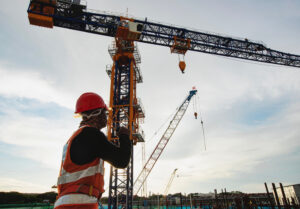Construction sites can often be among the most dangerous places to work, with the potential for serious accidents and injuries always present. With a high number of workers, heavy machinery, and complex workflows, it can be a challenge to maintain a safe working environment.
However, effective safety and compliance management can help improve construction safety by ensuring that all workers—whether employed directly or through subcontractors—adhere to strict and effective protocols that keep themselves and others around them safe. By taking proactive steps to prevent accidents, such as providing adequate training, ensuring proper use of safety equipment, and conducting regular safety inspections, you can significantly reduce the risk of legal action and financial liabilities. This is especially important in the construction industry, where accidents and injuries can result in significant medical bills, lost productivity, and legal expenses.
Here are some of the ways that effective management can help improve your construction site, and how you can begin implementing a strategy today to set yourself up for success in the long run.
Clear expectations and accountability
Effective contractor management is crucial in ensuring that all contractors and subcontractors are aware of safety expectations and are held accountable for meeting them. This includes providing clear guidelines for safety procedures and expectations, ensuring that everyone on the construction site is properly trained and equipped with the necessary safety equipment, and conducting regular safety inspections to ensure compliance. When everyone on the construction site is on the same page, it’s easier to enforce safety protocols and hold individuals and companies responsible for any violations.
Compliance with regulations and standards
As the host organization, it is your duty to ensure that all contractors and subcontractors comply with safety regulations and standards. This means that workers are trained on proper safety procedures, such as the correct use of personal protective equipment, and that safety protocols are enforced at all times. Furthermore, you’re also responsible for providing your workers with a workplace that is free of hazards, consistently maintained, and equipped with adequate safety signage. By adhering to these regulations and standards, the risk of accidents and injuries can be significantly reduced.
Improved communication and collaboration
An effective workforce is one that can communicate. As site manager or safety supervisor, you’re one of the many people who are in charge of taking the lead to improve communication and collaboration between all parties involved in a construction project. This means that safety concerns can be identified and addressed in a timely manner, your workers can alert others about potential hazards, and you’re able to take action on safety procedures much quicker. Additionally, improved communication and collaboration can help ensure that safety protocols are consistent across all contractors, leaving no one behind.
Risk management
It’s essential that you’re able to identify potential safety risks and develop strategies to mitigate them before they arise. This can include conducting periodical risk assessments, developing safety plans that account for unforeseen circumstances, and implementing immediate safety procedures to reduce the likelihood of any workplace risks arising. By proactively managing safety risks, you’re able to keep your workplace ahead of the curve and remain compliant at all times. It also equips you with better management skills that indirectly help other contractor management efforts such as safety training.
Enhanced safety training
Before, during, and after a project, organizations need to ensure that all workers are receiving adequate safety training. Contractors need to be trained before they arrive at the worksite, on an as-needed basis when you see a worker falling behind or carrying out a task incorrectly, and after the fact to ensure that what you’ve trained them on has indeed worked. This includes training on the use of personal protective equipment, safe handling of equipment and materials, and standard procedure such as lockout/tagout. By providing comprehensive training for your workforce, workers are better equipped to identify and avoid potential safety hazards. Furthermore, it instills confidence in them knowing that you take their wellbeing seriously, ultimately resulting in a more positive safety culture where everyone contributes equally.
Consistent safety auditing and monitoring
Effective contractor management ensures that safety teams have the means to facilitate consistent safety auditing and monitoring. This means that processes are regularly reviewed to ensure that they are effective and that workers are adhering to them. Regular workplace monitoring helps keep a steady eye on operations and can identify areas where safety protocols need to be improved. Often, safety teams monitor and manage the compliance of their workforce through automated technologies such as contractor management software for heightened accuracy and more streamlined workflows.
Reduced liability and risk
Managing your workers helps you reduce the liability and risk associated with hiring third parties for your construction projects. When safety protocols are followed and enforced, the rest of your operations are likely to follow suit. This can help reduce the risk of legal action and financial liabilities associated with accidents and injuries on the construction site. This is important because every recorded incident or compliance violation that is added to your record can significantly affect the trajectory of your business’ success.
Closing remarks
In conclusion, effective contractor management is essential for improving construction safety. By ensuring clear expectations and accountability, compliance with safety regulations and standards, improved communication and collaboration, increased risk management, enhanced safety training, consistent safety auditing and monitoring, and reduced liability and risk, your construction site can become a safer place to work. When workers feel safe and secure on the job, they are more likely to be productive and efficient, which can help to reduce the overall risk of the project. By prioritizing safety, construction companies can protect their workers, ensure sustained compliance and improve their overall productivity and business performance.
Addison Moore is Director of Marketing at Contractor Compliance.

